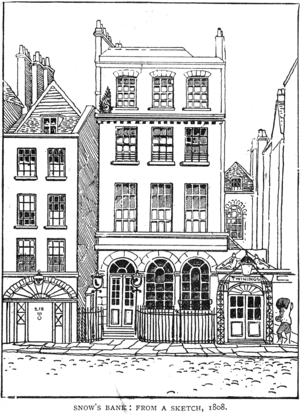
sloughs, very perilous and noisome." Yet it was by this miserable road that Cardinal Wolsey, with his great and stately retinue, passed daily from his house in Chancery-lane to Westminster Hall. In that respect there is nothing in the changed condition of things to regret; but we may, indeed, be sorry for this: that there is left, save in its churches, scarcely a brick of the old Strand.
Still there are memories enough, and for these we may be thankful. Think only of the processions that have passed up from Westminster to St. Paul's, or the other way about! Remember that wonderful cavalcade amid which Charles II. rode back from his Flemish exile to the palace which had witnessed his father's death. Nothing like it has been seen in England since. Evelyn has left us a description of the scene, which is the more dramatic for being brief: "May 29, 1660. This day His Majesty Charles II. came to London, after a sad and long exile and calamitous suffering, both of the King and Church, being seventeen years. This was also his birthday, and, with a triumph above 20,000 horse and foot, brandishing their swords and shouting with inexpressible joy; the way strew'd with flowers, the bells ringing, the streets hung with tapestry, fountains running with wine; the mayor, aldermen, and all the companies in their liveries, chains of gold, and banners; lords and nobles clad in cloth of silver, gold, and velvet; the windows and balconies well set with ladies; trumpets, music, and myriads of people. . . . They were eight hours passing the city, even from two till ten at night. I stood in the Strand, and beheld it, and bless'd God." A century earlier Elizabeth had gone in state to St. Paul's, to return thanks for the destruction of the Armada. Next, Queen Anne went in triumph up to St. Paul's, after Blenheim; and, long after, the funeral processions of Nelson and Wellington were added to the list of great historic sights which the Strand has seen. The most recent of these great processions was the Prince of Wales's progress of thanksgiving to St. Paul's in 1872.
Immediately we leave what was Temple Bar, the Strand's memories begin. We have made only a few steps from Temple Bar, when we come to a house—No. 217, now a branch of the London and Westminster Bank—which, after a long and respectable history, saw its owners at length overtaken by shame and ruin. It was the banking-house of Strahan, Paul & Bates, which had been founded by one Snow and his partner Walton in Cromwell's days. In the beginning the house was "The Golden Anchor," and Messrs. Strahan & Co. have among their archives ledgers (kept in decimals!) which go back to the time of Charles II.
In 1855 it was discovered that some of the partners had been using their customers' money for their own pleasures or necessities. The guilty persons all went to prison; one of the few instances in which, as in the case of Fauntleroy, who was hanged for forgery, English bankers have been convicted of breach of trust. Adjoining this house is that of Messrs. Twining, who opened, in 1710, the first tea-shop in London. They still deal in tea, though fine ladies no longer go to the Eastern
